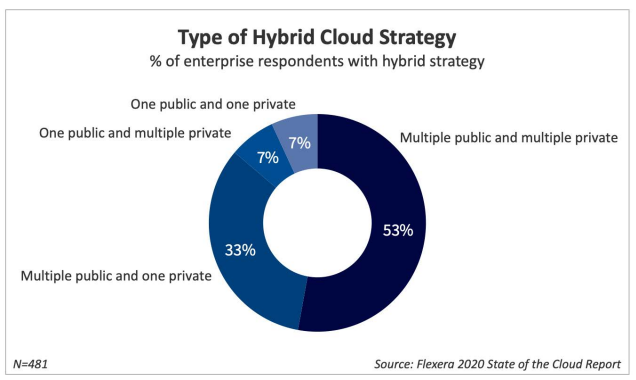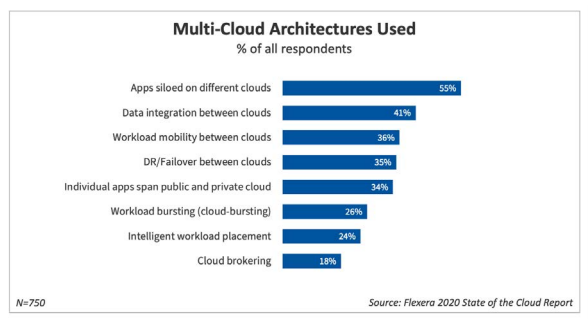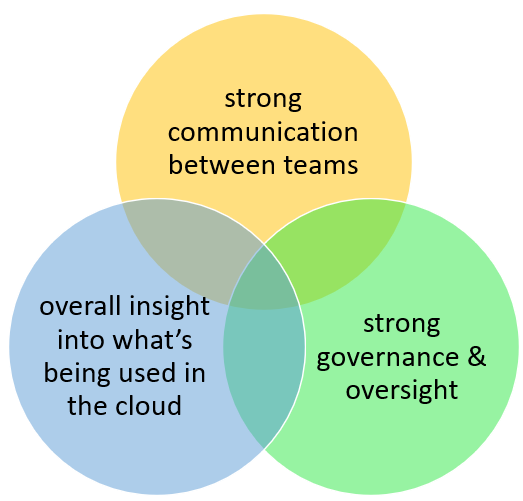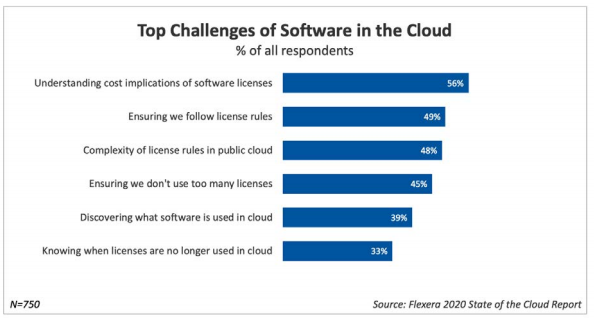The benefits and dangers of multi-cloud
This article looking at the benefits and dangers of multi-cloud was written by Rich Gibbons, ITAM Review, and Kevin Miller, Senior Product Marketing Manager, Flexera.

It’s pretty much accepted that public cloud – aka IaaS (Infrastructure as a Service) – is a big benefit to organisations and is here to stay. If one cloud can reduce costs, increase productivity, streamline workloads and more…then two clouds must be even better, and three would be amazing, right?!
When you dig into the cloud usage in your organisation, you might feel that the above logic has been applied – why would you have multiple clouds? Surely it’s better to settle on one cloud provider? It’s rare that organisations are totally faithful to a single vendor or tool on-premises – I’d wager most organisations have got multiple video conferencing tools, multiple cloud storage tools, multiple databases (SQL & Oracle probably) etc. – and public cloud is no different.
Let’s look at some data
Flexera’s State of the Cloud Report 2020 shows 86% of respondents are using multiple public clouds:

So the logical question is…
Why multi-cloud?
Some organisations will have planned to adopt a multi-cloud approach while others will find they’ve arrived there largely by accident. Either way, there are several reasons that a multi-cloud approach will be in place – the ones I want to focus on here are:
- Different clouds = different tech
- Protect against vendor lock-in
- Disaster Recovery
- Pricing
Different clouds = different tech
Although the major public cloud providers appear, at a high level, broadly similar in terms of the services they offer, there are plenty of differences at a more granular level. These differences can include the specific technologies offered, the way they interact with existing services, the experience/preference of the teams deploying to the cloud and several others too. While it is important to choose the providers that offer the best technology and also to accommodate the existing experiences within your organisation – such as programming languages or environment familiarity – 55% of survey respondents said that the result of multi-cloud is that applications become siloed in different clouds:

Protect against vendor lock-in
Historically, being “locked-in” to one vendor has been a concern for organisations, with worries that it can adversely affect your ability to negotiate on price and concessions. For many, this carries over into the cloud world – particularly as the public cloud vendor also has access to, and possibly control over, your data. Retaining the ability to easily switch to a competitor, or at least threaten to do so during a negotiation, can remain important to some with an organisation.
Disaster Recovery
Public cloud outages do happen – Microsoft, Amazon, Google, IBM and more have all had downtime in recent memory. Yes, such outages are rarely total and often just certain services and/or regions are impacted but if that’s your service or region, the fact it isn’t global is little comfort.
If you build your production environment on a single cloud platform and there IS a problem – what do you do? Disaster recovery, redundancy, and resiliency are all key tenets of technology planning and nothing changes in the cloud. While all the public cloud vendors offer the ability to fail-over to different parts of their cloud – different datacentres/regions for example – some organisations may prefer to have the option to bring up systems on a totally separate platform, for added re-assurance in a true disaster.
Pricing
Price differences between the cloud providers can make it more financially attractive for an organisation to have different tools and services spread across the public clouds. In some cases, this is simply that the face value “per-minute” cost in one cloud is cheaper than in another, but in other scenarios it can be more complicated – as we shall see a little later.
Dangers of multi-cloud

There are also several dangers to a multi-cloud strategy and, as this is becoming the norm for an increasing number of organisations, it is key that ITAM managers understand the dangers and how to address them. Positioning ITAM as the team to identify and address these issues can help increase the internal profile of ITAM and, aligning yourself with key corporate goals such as cost reduction and cloud governance, will also help increase visibility with the C-suite.
Duplicated resources
This issue typically arises where there is little communication between the internal teams utilising public cloud and is surely responsible for a good portion of wasted cloud spend; it’s essentially “different teams doing the same thing in different clouds”. It could be simple things like virtual machines or more complex offerings such as database services, machine learning, containers and more. Regardless of the technology that is being duplicated, the methods to resolve the problem are the same. You need:
- strong communication between teams
- strong governance & oversight
- overall insight into what’s being used in the cloud

If teams and projects are siloed, there is a greater likelihood of resources being duplicated. While managing communications between the various cloud teams isn’t an ITAM objective, serving as a central hub through which all this data can be collected, shared, and analysed certainly could be. This will also help raise the profile and strategic importance of ITAM within the organisation as the move to cloud continues.
Cloud sprawl
Those of you who have managed assets within a virtualised environment are probably familiar with “VM sprawl” – where virtual machines just keep on appearing until things become close to unmanageable. Imagine those same people deploying to the public cloud – where there are almost no capacity limits and you pay for everything that’s turned on.
Cloud sprawl is a real problem and multi-cloud exacerbates it. Instead of one almost limitless space in which to deploy resources, now you have two or three – or more! Multi-cloud means multiple spaces for resources to be over-provisioned and/or left on unnecessarily.
Different pricing and discount models
The cloud has opened up a whole new world of metrics, measurements, and payment methods – many of which differ between the different public cloud providers. Cloud pricing models are complex and each additional cloud provider your organisation uses increases the quantity and complexity of cloud cost management.
A good example of this is Reserved Instances (RI) – a method of pre-paying for cloud resources to secure a discount over “Pay As You Go” (PAYG) pricing that exists in both Amazon AWS and Microsoft Azure.
Amazon
There are two primary types of RI available with Amazon EC2:
- Standard
- Convertible
Which offer different levels of discount. Both are available in one- or three-year terms but feature varying restrictions around the ability to modify features of the resources purchased. There are then three payment options available:
- All Upfront
- Partial Upfront
- No Upfront
Which impact the total amount payable as well as internal budget allocation and cashflow. Amazon RIs cannot be cancelled.
Microsoft
Reserved Instances for virtual machines in Microsoft Azure are available in one, three, or five-year terms payable on a monthly or annual basis. They can be exchanged (with caveats) and cancelled although early termination fees apply in the latter scenario.
This brief overview of Reserved Instances across the two leading cloud providers shows that what appears to be a straightforward concept quickly becomes complicated in a multi-cloud environment. Should other cloud environments be included, such as Google Cloud Platform and its “Committed Use Discounts”, that complexity continues to increase.
Different licensing rules
While cost management is generally the number one cloud priority for organisations, license compliance must not be forgotten. According to the Flexera 2020 State of the Cloud report, some of the top challenges of software in the cloud included managing software licenses:

These concerns are all amplified for organisations taking a multi-cloud approach. Most software vendors have specific rules that apply when their software licenses are used in the cloud and these can vary depending on the specific combination of vendors in your particular licensing equation.
Licensing examples
The following three examples do a great job of showcasing the additional levels of complexity that can be introduced by a multi-cloud strategy:
- Oracle only recognise Amazon AWS and Microsoft Azure as “Authorized Cloud Platforms” – software deployed in other clouds is subject to different rules.
- IBM’s PVU metric is doubled when the software is used in Oracle’s cloud environment, compared to other cloud environments.
- Microsoft’s “Listed Provider” change in October 2019 altered licensing rules for dedicated environments held with Amazon, Google, and Alibaba – the rules remain the same for other cloud providers.
These, and other, licensing rules mean that a scenario can be perfectly compliant in one cloud, but should some or all of those workloads be migrated to another cloud environment, at least part of it may become non-compliant in its new location.
Managing this successfully requires not only that ITAM have an up-to-date, complete overview of software licenses used in cloud environments but also, ideally, a tool or process that gives ITAM visibility before these licenses are deployed. IaaS and on-premises, alongside SaaS as well, are all key elements of an organisation’s need for IT visibility – being able to see everything all at once, no matter where it sits.
As the ITAM landscape rapidly evolves alongside the technologies it supports, we’ll continue to see dynamic environments like cloud play an integral role in how organizations manage their IT assets.
With thousands of applications and services scattered across hundreds of providers—from on premises to the cloud— effectively managing requires complete, accurate and up-to-date visibility into the entire IT estate
Conclusion
Multi-cloud environments within organisations are a reality so we must be alert to the potential hazards, understand their impacts, and identify how best to address them. Engaging with stakeholders is key to this; working alongside teams to both gather up all the pieces of the puzzle and also to show them the final result is the only way to truly succeed. Do this well and several benefits await, including better:
- ITAM data
- Cost management
- Relationships with your peers
- Engagement with the C-Suite
Multi-cloud is here to stay – work now to bring it under control as efficiently as possible.
ITAM’s role can – and will – become more prominent within organizations as various internal stakeholders find their footing within this shifting infrastructure and recognize the importance of highlighting the interdependencies of all of these assets.
Further Reading
About Rich Gibbons
A Northerner renowned for his shirts, Rich is a big Hip-Hop head, and loves travel, football in general (specifically MUFC), baseball, Marvel, and reading as many books as possible. Finding ways to combine all of these with ITAM & software licensing is always fun!
Connect with Rich on Twitter or LinkedIn.
